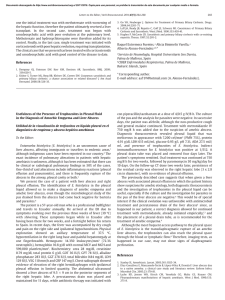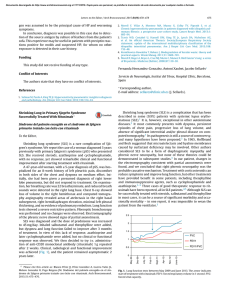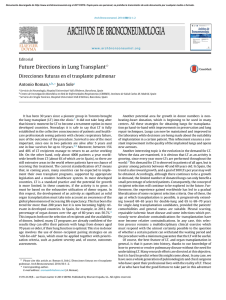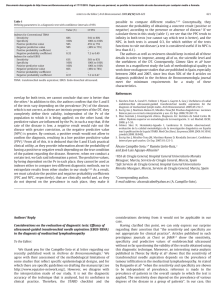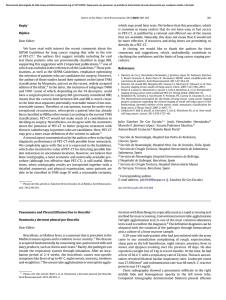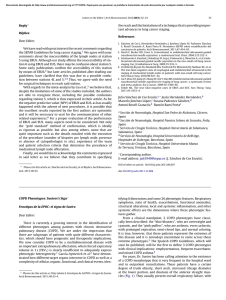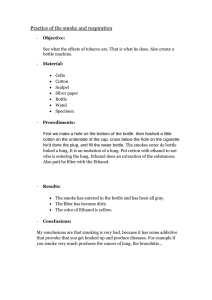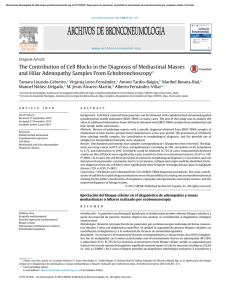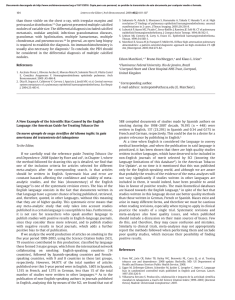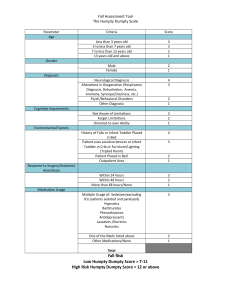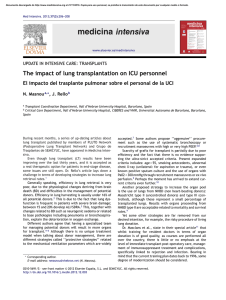Endobronchial Ultrasound in the Diagnosis of Lung Cancer
Anuncio
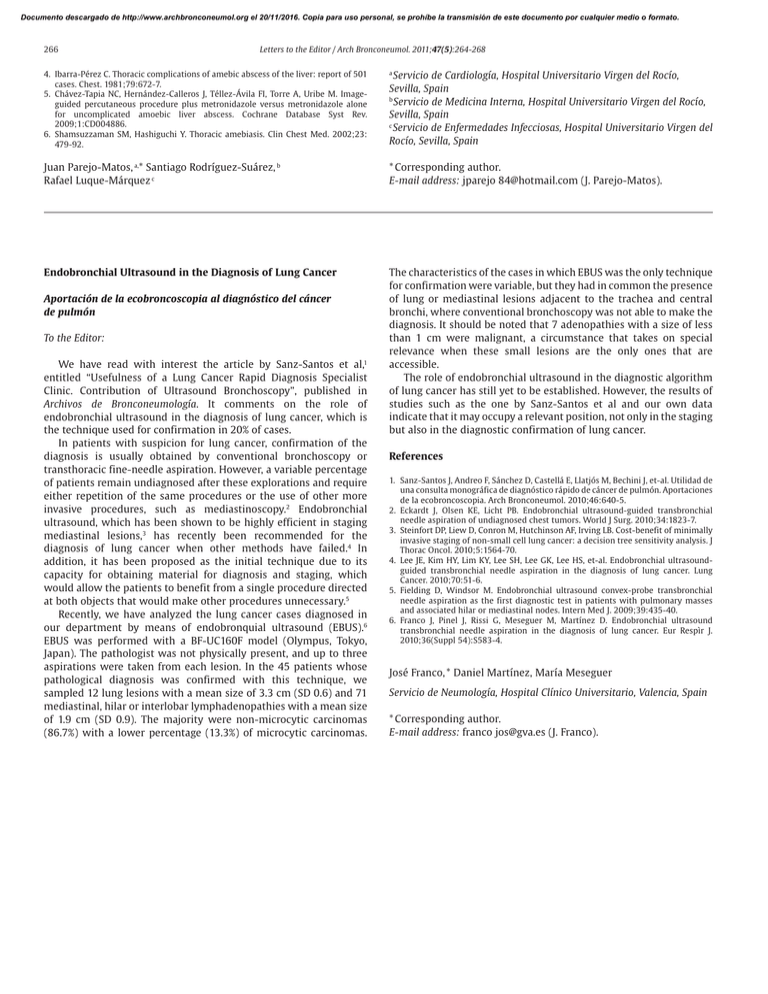
Documento descargado de http://www.archbronconeumol.org el 20/11/2016. Copia para uso personal, se prohíbe la transmisión de este documento por cualquier medio o formato. 266 Letters to the Editor / Arch Bronconeumol. 2011;47(5):264-268 4. Ibarra-Pérez C. Thoracic complications of amebic abscess of the liver: report of 501 cases. Chest. 1981;79:672-7. 5. Chávez-Tapia NC, Hernández-Calleros J, Téllez-Ávila FI, Torre A, Uribe M. Imageguided percutaneous procedure plus metronidazole versus metronidazole alone for uncomplicated amoebic liver abscess. Cochrane Database Syst Rev. 2009;1:CD004886. 6. Shamsuzzaman SM, Hashiguchi Y. Thoracic amebiasis. Clin Chest Med. 2002;23: 479-92. a Servicio de Cardiología, Hospital Universitario Virgen del Rocío, Sevilla, Spain b Servicio de Medicina Interna, Hospital Universitario Virgen del Rocío, Sevilla, Spain c Servicio de Enfermedades Infecciosas, Hospital Universitario Virgen del Rocío, Sevilla, Spain Juan Parejo-Matos, a,* Santiago Rodríguez-Suárez, b Rafael Luque-Márquez c * Corresponding author. E-mail address: jparejo [email protected] (J. Parejo-Matos). Endobronchial Ultrasound in the Diagnosis of Lung Cancer The characteristics of the cases in which EBUS was the only technique for confirmation were variable, but they had in common the presence of lung or mediastinal lesions adjacent to the trachea and central bronchi, where conventional bronchoscopy was not able to make the diagnosis. It should be noted that 7 adenopathies with a size of less than 1 cm were malignant, a circumstance that takes on special relevance when these small lesions are the only ones that are accessible. The role of endobronchial ultrasound in the diagnostic algorithm of lung cancer has still yet to be established. However, the results of studies such as the one by Sanz-Santos et al and our own data indicate that it may occupy a relevant position, not only in the staging but also in the diagnostic confirmation of lung cancer. Aportación de la ecobroncoscopia al diagnóstico del cáncer de pulmón To the Editor: We have read with interest the article by Sanz-Santos et al,1 entitled “Usefulness of a Lung Cancer Rapid Diagnosis Specialist Clinic. Contribution of Ultrasound Bronchoscopy”, published in Archivos de Bronconeumología. It comments on the role of endobronchial ultrasound in the diagnosis of lung cancer, which is the technique used for confirmation in 20% of cases. In patients with suspicion for lung cancer, confirmation of the diagnosis is usually obtained by conventional bronchoscopy or transthoracic fine-needle aspiration. However, a variable percentage of patients remain undiagnosed after these explorations and require either repetition of the same procedures or the use of other more invasive procedures, such as mediastinoscopy.2 Endobronchial ultrasound, which has been shown to be highly efficient in staging mediastinal lesions,3 has recently been recommended for the diagnosis of lung cancer when other methods have failed.4 In addition, it has been proposed as the initial technique due to its capacity for obtaining material for diagnosis and staging, which would allow the patients to benefit from a single procedure directed at both objects that would make other procedures unnecessary.5 Recently, we have analyzed the lung cancer cases diagnosed in our department by means of endobronquial ultrasound (EBUS).6 EBUS was performed with a BF-UC160F model (Olympus, Tokyo, Japan). The pathologist was not physically present, and up to three aspirations were taken from each lesion. In the 45 patients whose pathological diagnosis was confirmed with this technique, we sampled 12 lung lesions with a mean size of 3.3 cm (SD 0.6) and 71 mediastinal, hilar or interlobar lymphadenopathies with a mean size of 1.9 cm (SD 0.9). The majority were non-microcytic carcinomas (86.7%) with a lower percentage (13.3%) of microcytic carcinomas. References 1. Sanz-Santos J, Andreo F, Sánchez D, Castellá E, Llatjós M, Bechini J, et-al. Utilidad de una consulta monográfica de diagnóstico rápido de cáncer de pulmón. Aportaciones de la ecobroncoscopia. Arch Bronconeumol. 2010;46:640-5. 2. Eckardt J, Olsen KE, Licht PB. Endobronchial ultrasound-guided transbronchial needle aspiration of undiagnosed chest tumors. World J Surg. 2010;34:1823-7. 3. Steinfort DP, Liew D, Conron M, Hutchinson AF, Irving LB. Cost-benefit of minimally invasive staging of non-small cell lung cancer: a decision tree sensitivity analysis. J Thorac Oncol. 2010;5:1564-70. 4. Lee JE, Kim HY, Lim KY, Lee SH, Lee GK, Lee HS, et-al. Endobronchial ultrasoundguided transbronchial needle aspiration in the diagnosis of lung cancer. Lung Cancer. 2010;70:51-6. 5. Fielding D, Windsor M. Endobronchial ultrasound convex-probe transbronchial needle aspiration as the first diagnostic test in patients with pulmonary masses and associated hilar or mediastinal nodes. Intern Med J. 2009;39:435-40. 6. Franco J, Pinel J, Rissi G, Meseguer M, Martínez D. Endobronchial ultrasound transbronchial needle aspiration in the diagnosis of lung cancer. Eur Respìr J. 2010;36(Suppl 54):S583-4. José Franco, * Daniel Martínez, María Meseguer Servicio de Neumología, Hospital Clínico Universitario, Valencia, Spain * Corresponding author. E-mail address: franco [email protected] (J. Franco).
